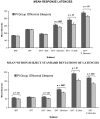Psychomotor performance deficits and their relation to prior nights' sleep among individuals with primary insomnia
- PMID: 18517030
- PMCID: PMC2398751
- DOI: 10.1093/sleep/31.5.599
Psychomotor performance deficits and their relation to prior nights' sleep among individuals with primary insomnia
Abstract
Objective: To examine psychomotor (reaction time) performance deficits and their relation to subjective and objective sleep measures among individuals with primary insomnia (PI).
Design and setting: This study was conducted at affiliated VA and academic medical centers using a matched-groups, cross-sectional research design.
Participants: Seventy-nine (43 women) individuals with PI (MAge = 50.0 +/- 17.1 y) and 84 (41 women) well-screened normal sleepers (MAge = 48.6 +/- 16.8 y).
Methods and measures: Participants underwent 3 nights of polysomnography (PSG) followed by daytime testing with a 4-trial multiple sleep latency test (MSLT). Before each MSLT nap, they rated their sleepiness and completed a performance battery that included simple reaction time (SRT), continuous performance (CPT), and 4 switching attention (SAT) tests. Performance measures included the mean response latency and the standard deviation of each subject's within-test response latencies.
Results: PI sufferers reported greater (P = 0.001) daytime sleepiness, but were significantly (P = 0.02), more alert than normal sleepers on the MSLT. Multivariate analyses showed the PI group had significantly longer response latencies and greater response variability across many of the subtests than did the controls. Regression analyses showed that both PSG- and diary-based sleep measures contributed to the prediction of daytime performance indices, although objective wake time after sleep onset appeared the best single predictor of the daytime measures.
Conclusions: Results confirm that PI sufferers do show relative psychomotor performance deficits when responding to challenging reaction time tasks, and these deficits appear related to both objective and subjective sleep deficits. Findings support PI patients' diurnal complaints and suggest the usefulness of complex reaction time tasks for assessing them.
Figures

Comment in
-
Towards an improved neuropsychology of poor sleep?Sleep. 2008 May;31(5):591-2. doi: 10.1093/sleep/31.5.591. Sleep. 2008. PMID: 18517027 Free PMC article. No abstract available.
References
-
- Ohayon MM. Epidemiology of insomnia: what we know and what we still need to learn. Sleep Med Rev. 2002;6:97–111. - PubMed
-
- Ohayon MM. Prevalence of DSM-IV diagnostic criteria of insomnia: Distinguishing insomnia related to mental disorders from sleep disorders. J Psychiatr Res. 1997;31:333–46. - PubMed
-
- Simon GE, VonKorff M. Prevalence, burden, and treatment of insomnia in primary care. Am J Psychiatry. 1997;154:1417–23. - PubMed
-
- Coleman RM, Roffwarg HP, Kennedy SJ, et al. Sleep wake disorders based on polysomnographic diagnosis: A national cooperative study. JAMA. 1982;247:997–1103. - PubMed
-
- Hajak G SINE Study Group Study of Insomnia in Europe. Epidemiology of severe insomnia and its consequences in Germany. Eur Arch Psychiatry Clin Neurosci. 2001;251:49–56. - PubMed
Publication types
MeSH terms
Grants and funding
LinkOut - more resources
Full Text Sources
Medical
Research Materials
Miscellaneous

